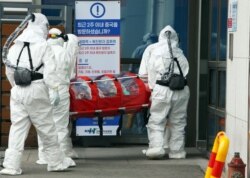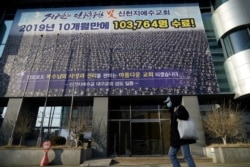The coronavirus continued to spread rapidly in South Korea on Saturday, with the country reporting its largest single-day spike in confirmed infections since the outbreak began.
The Korea Centers for Disease Control and Prevention reported 229 new coronavirus cases, bringing the total number of South Korean infections to 433.
That is a drastic increase from four days ago, when there were only 31 confirmed infections. South Korea now has the highest number of cases outside of China and a cruise ship off the coast of Japan.
Authorities are vowing more effective containment efforts, even as protesters in Seoul on Saturday defied a local government ban on large rallies.
Wearing masks and chanting anti-government slogans, hundreds of mostly older conservative protesters packed tightly into a square in Seoul’s central Gwanghwamun district, where feisty protests are held nearly every weekend.
Confusing messages
Police warned protesters they could be fined up to $2500 for violating the ban, but made no attempts to disperse the crowd. At one point, Seoul Mayor Park Won-soon pleaded with protesters to go home, saying they posed a risk to public safety.
"It can not only hurt you, but also impact the safety and health of your neighbors,” Park said, according to the Yonhap news agency.
But some of the protesters told VOA they believed the virus could not spread among crowds, as long as they were gathered outside -- an incorrect notion that may have stemmed from comments by a protest leader, as reported by CNN.
Lee Gun, a 61-year-old, said he believes large groups are safe as long as they are in an open space. “I came to worship and pray for my country,” said Lee, proudly displaying a Bible. The weekly gatherings often have religious themes.
"It is not risky as long as it is in an open area,” said Gang Bo-mun, a 65-year-old from Gyeongnam province. He said he was not worried about the threat of a fine, which he believed was intended to shut down political participation.
Seoul officials have defended the ban on large urban rallies, noting that weekend protests in Gwanghwamun are usually composed of older protesters, who are much more susceptible to the coronavirus.
According to a report this week by the Chinese Center for Disease Control and Prevention, the overall coronavirus fatality rate is 2.3 percent. But that figure spiked to almost 15 percent in infections of people over age 80.
China still epicenter
The highly contagious virus, which causes a pneumonia-like respiratory illness known as COVID-19, has killed more than 2,300 people and infected more than 75,000 worldwide. Nearly all of the infections have been in China, where the virus originated.
So far, only two coronavirus patients have died in South Korea. But with the number of virus cases having nearly doubled for four consecutive days, many fear the worst is yet to come.
Most of the South Korean infections have been in the southeastern city of Daegu and the nearby county of Cheongdo.
In Seoul, which has seen a smaller surge of new infections, virtually all commuters on public buses and trains wore masks and exchanged nervous glances if someone sneezed or coughed.
"It looks like a scene from a disaster movie," said Choi In-woo, a 20-year-old freshman university student in the Gwanghwamun neighborhood of the Jongno district, which reported the most new cases in the capital this week.
"I'm really scared if it lasts longer," said Choi, whose university has canceled orientation for the spring semester.
Many conservative forces have called on the government to further tighten restrictions on the entry people from China. An editorial this week in the conservative Chosun Ilbo compared the government’s efforts to trying to “catch flies with the windows wide open.”
There are concerns that fears of the virus are becoming entangled with anti-China sentiment. Some restaurant owners in Seoul placed “no Chinese” or “no foreigners” signs outside their businesses. A delivery drivers’ union requested its members not be required to take food to neighborhoods with large Chinese populations. And a petition with over 700,000 signatures is calling for the government to ban entry to Chinese nationals.
But authorities say the virus has now begun spreading locally among people with no links to China.
Religious group
More than half of the infections are linked to a fringe religious congregation in the southeastern city of Daegu, where a 61-year-old woman who tested positive for the virus had worshiped.
The Shincheonji Church of Jesus the Temple of the Tabernacle of the Testimony was founded in 1984 by Lee Man-hee, who is revered by his followers as a messiah. The group claims to have approximately 200,000 followers in South Korea.
The Yonhap news agency reported that the virus may have spread more easily at the religious gatherings, since its adherents sit close together on the floor and often place their hands on one another.
Lee, the leader of the group, has said the virus is the “work of the devil.” He has also temporarily closed all his churches, saying members should instead watch services on YouTube.
Lee Juhyun contributed to this report.










